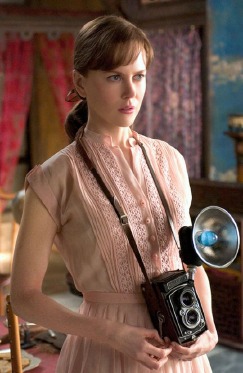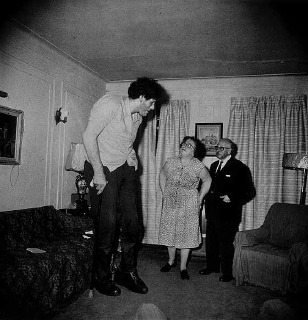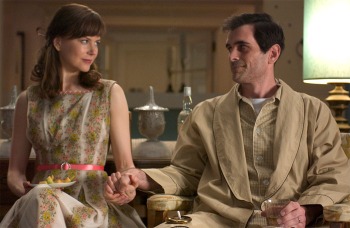
Musings on Photographer Diane Arbus and the Biopic:
"Fur: An Imaginary Portrait of Diane Arbus"
Two of my more bizarre childhood memories include attending midget wrestling matches with my embarrassingly eccentric mother and annual tours of the side (or freak) shows at the county fair. Long before the era of political correctness, the names of these exhibitions were as offensive as the displays themselves: pinheads (bullet head syndrome), mongoloids (Down syndrome), Siamese (conjoined) twins, "human blimps," bearded ladies. I found them fascinating. Pitiable, yes; sometimes frightening. Perhaps because I was only a child (and an only child), I identified with their vulnerability, their isolation, their disadvantaged confinement, even their degraded social misery. My biggest thrill was to reach out and touch the female "pinhead," finger-to-finger, an ersatz Michelangelo's "Creation of Adam."
 While watching "Fur," the uneven new biopic of photographer Diane Arbus, directed by Steven Shainberg, I was reminded of these childhood experiences of society's misfits and outcasts, which paralleled Arbus's strangely compelling aberrant images. (The HBO series "Carnival," now in its third season, is a dark excursion into the bizarre adventures of a circa 1930s Oklahoma Dustbowl traveling sideshow, replete with carnies, fortune-tellers, and dwarfs, exemplary of the creatures Tod Browning highlighted in his 1936 film "Freaks.") While watching "Fur," the uneven new biopic of photographer Diane Arbus, directed by Steven Shainberg, I was reminded of these childhood experiences of society's misfits and outcasts, which paralleled Arbus's strangely compelling aberrant images. (The HBO series "Carnival," now in its third season, is a dark excursion into the bizarre adventures of a circa 1930s Oklahoma Dustbowl traveling sideshow, replete with carnies, fortune-tellers, and dwarfs, exemplary of the creatures Tod Browning highlighted in his 1936 film "Freaks.")
During my training in art history and as a visual artist at Berkeley, I first discovered (and felt an immediate affinity with) the valiantly intrepid photography of Diane Arbus, best known for her photos of "The Jewish Giant" and dwarfs, arm- and legless carnival performers, albino sword-swallowers, female impersonators, nudists, seemingly comfortable in their own skins, "The Marked [Tattooed] Man," multiple pairs of twins, the mentally challenged, the insane. Disorders similar, in other words, to those I'd experienced at the county fairs during my youth.
In her 1973 essay "On Photography," Susan Sontag accused Arbus of conveying an "anti-humanist message." Nothing could be further from the truth. Arbus emotionally and creatively embraced these "others." (According to her biographer Patricia Bosworth, Arbus approached her work as a contemporary cultural anthropologist.) Her photographs--portraying the extraordinary as ordinary and acceptable--at once riveted and repelled. They made me want to know more about the subjects as well as the artist, to reach out to both. (The name Diana signifies the Roman moon goddess of the hunt, which is, after all, what a photographer/voyeur does: She tracks her subject and "shoots" it. About her process, Arbus once wrote in her journal: "I am creeping forward on my belly like they do in war movies.")
 By the time I encountered her work, Arbus had been dead for several years. A life-long sufferer of depression, on July 26th, 1971, at the age of 48, she downed a bottle of barbiturates, stepped, fully clothed, into an empty bathtub, slit her wrists, and slowly bled to death. That same morning, the Apollo 15 astronauts were launched to the moon. By the time I encountered her work, Arbus had been dead for several years. A life-long sufferer of depression, on July 26th, 1971, at the age of 48, she downed a bottle of barbiturates, stepped, fully clothed, into an empty bathtub, slit her wrists, and slowly bled to death. That same morning, the Apollo 15 astronauts were launched to the moon.
In 2003, at the SF MoMA and the LA County Museum, I twice attended an Arbus retrospective. But unlike standard exhibitions, the 200 photographs hovered around a theatrically situated installation of biographical materials--snapshots, letters, notebooks, cameras, keepsakes. This personal paraphernalia captured the photographer's persona, alternately soaring with curiosity and plaintive with grief. And those photos! The subjects' gazes burst forth from the confines of their oversized prints. Strange, yet ever human.
 As the film's subtitle suggests, "Fur" is "An Imaginary Portrait of Diane Arbus." The term "Imaginary" is less an understatement, than a fair warning. There may be viewers who effortlessly transpose the tall, transparently thin, natural blond, ethereal sylph that is Nicole Kidman with the petite, dark-haired, haunted-looking, earthy Diane Arbus, but I am not one of them. Director Steven Shainberg (whose "Secretary," starring Maggie Gyllenhaal, was startlingly original and effective) creates an ominous atmosphere in a Dakota-like apartment building. His creaking doors and moody music seem more suited to "Rosemary's Baby." Still, Shainberg's metaphoric examination of Arbus's brooding subconscious, using ladders and basements and individuals with physical and psychological abnormalities earnestly attempts to convey an emerging artistic vision. In "Fur," Robert Downey, Jr., embodies the true revelation. Portraying a hirsute neighbor of Arbus and her family, Downey's eyes, and later his psychologically naked face bear the discomfiting authenticity of a man who has returned from the brink of moral corruption and death. But, if you're looking for Diane Arbus, study her photographs first hand, or, take in a sideshow at a county fair. As the film's subtitle suggests, "Fur" is "An Imaginary Portrait of Diane Arbus." The term "Imaginary" is less an understatement, than a fair warning. There may be viewers who effortlessly transpose the tall, transparently thin, natural blond, ethereal sylph that is Nicole Kidman with the petite, dark-haired, haunted-looking, earthy Diane Arbus, but I am not one of them. Director Steven Shainberg (whose "Secretary," starring Maggie Gyllenhaal, was startlingly original and effective) creates an ominous atmosphere in a Dakota-like apartment building. His creaking doors and moody music seem more suited to "Rosemary's Baby." Still, Shainberg's metaphoric examination of Arbus's brooding subconscious, using ladders and basements and individuals with physical and psychological abnormalities earnestly attempts to convey an emerging artistic vision. In "Fur," Robert Downey, Jr., embodies the true revelation. Portraying a hirsute neighbor of Arbus and her family, Downey's eyes, and later his psychologically naked face bear the discomfiting authenticity of a man who has returned from the brink of moral corruption and death. But, if you're looking for Diane Arbus, study her photographs first hand, or, take in a sideshow at a county fair.
Home | About: Site Philosophy | About: Cathleen | About: The Book | Reviews: Current | Reviews: Archive
Purchase the book! | Festival Dispatches | The Movie Lovers' Club | Links | Contact

All text on this website copyright © 2006 Cathleen Rountree. All images and graphics copyright their respective owners, unless otherwise noted. Design by Jay Wertzler.
|
